RAA Pre Cert Legislation 1 Pilot Practice Exam
Join Our Successful Graduates!
Quiz-summary
0 of 20 questions completed
Questions:
- 1
- 2
- 3
- 4
- 5
- 6
- 7
- 8
- 9
- 10
- 11
- 12
- 13
- 14
- 15
- 16
- 17
- 18
- 19
- 20
Information
Pre-Solo Legislation
Please note this has not been updated since introduction of Part 61
You have already completed the quiz before. Hence you can not start it again.
Quiz is loading...
You must sign in or sign up to start the quiz.
You have to finish following quiz, to start this quiz:
Results
0 of 20 questions answered correctly
Your time:
Time has elapsed
You have reached 0 of 0 points, (0)
Categories
- Not categorized 0%
-
Congratulations and thanks for taking the practice exam. Join All The Other Successful Graduates Who Saved 50% Study Time! JOIN NOW!
- 1
- 2
- 3
- 4
- 5
- 6
- 7
- 8
- 9
- 10
- 11
- 12
- 13
- 14
- 15
- 16
- 17
- 18
- 19
- 20
- Answered
- Review
-
Question 1 of 20
1. Question
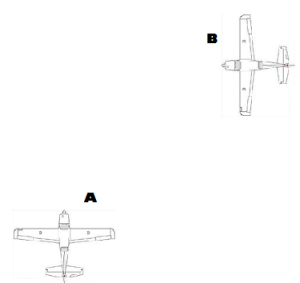
In the diagram above, which aircraft has to give way?
Correct
Give way to your right. But in all situations avoid accidents and be considerate.

91.330 Right of way rules – item 6

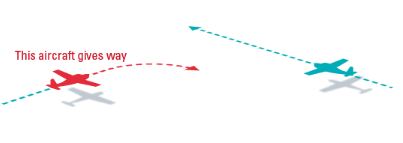 Incorrect
Incorrect
Give way to your right. But in all situations avoid accidents and be considerate.

91.330 Right of way rules – item 6


-
Question 2 of 20
2. Question

In the diagram above, which method of giving way is most correct?Correct
Clearly needs to turn right well prior to the location that would cause the aircraft to be closer. This diagram is not to scale.
Incorrect
Clearly needs to turn right well prior to the location that would cause the aircraft to be closer. This diagram is not to scale.
-
Question 3 of 20
3. Question
If on a head on collision path with another aircraft:
Correct
Both aircraft should take evasive action to the right. Often one pilot won’t even see the other due to distractions, monitoring gauges or navigation etc. It is important both pilots take immediate evasive action as you only have seconds.
From VFRG version 7.0
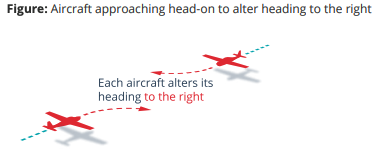 Incorrect
Incorrect
Both aircraft should take evasive action to the right. Often one pilot won’t even see the other due to distractions, monitoring gauges or navigation etc. It is important both pilots take immediate evasive action as you only have seconds.
From VFRG version 7.0

-
Question 4 of 20
4. Question

In the diagram above:Correct
The slower aircraft maintains heading. The faster aircraft passes on the right. Stay well clear and let them know you are doing so.
The overtaking aircraft must give way to the aircraft being overtaken.From VFRG version 7.0
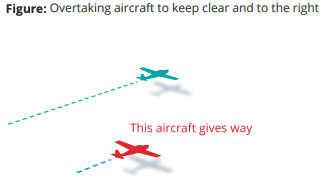 Incorrect
Incorrect
The slower aircraft maintains heading. The faster aircraft passes on the right. Stay well clear and let them know you are doing so.
The overtaking aircraft must give way to the aircraft being overtaken.From VFRG version 7.0

-
Question 5 of 20
5. Question
When aircraft A is heading 000° at 1000 feet and aircraft B is heading 315°, they will collide if they continue at the same speed as they are currently doing, then:
Correct
Aircraft A is heading 000 which is North. Aircraft B must be on its right if its heading for the same collision point and heading 315. Give way to your right.
It seems strange to turn to the right when an aircraft is on your right, however the correct technique is to speed up or slow down and maintain separation. It is generally easier and safer to slow down than turn right behind them, since we are often cruising at higher power settings, it is hard to speed up by much. It is also difficult to see behind so speeding up puts you in a position where you cannot see the aircraft you need to give way to.
Incorrect
Aircraft A is heading 000 which is North. Aircraft B must be on its right if its heading for the same collision point and heading 315. Give way to your right.
It seems strange to turn to the right when an aircraft is on your right, however the correct technique is to speed up or slow down and maintain separation. It is generally easier and safer to slow down than turn right behind them, since we are often cruising at higher power settings, it is hard to speed up by much. It is also difficult to see behind so speeding up puts you in a position where you cannot see the aircraft you need to give way to.
-
Question 6 of 20
6. Question
In regards to a landing aircraft, who has right of way over an aircraft wanting to enter and line up for takeoff?
Correct
A landing aircraft does have right of way over any aircraft taxiing or flying in the vicinity. The exception to this is aircraft already on the runway own the runway. If you are landing too close behind another aircraft and they take too long to vacate then you must go around.
An aircraft that enters a runway and forces another aircraft to go around is guilty of a reportable runway incursion.

91.330 Right of way rules – item 2
 Incorrect
Incorrect
A landing aircraft does have right of way over any aircraft taxiing or flying in the vicinity. The exception to this is aircraft already on the runway own the runway. If you are landing too close behind another aircraft and they take too long to vacate then you must go around.
An aircraft that enters a runway and forces another aircraft to go around is guilty of a reportable runway incursion.

91.330 Right of way rules – item 2

-
Question 7 of 20
7. Question
When two aircraft are approaching an aerodrome for the purpose of landing:
Correct

91.330 Right of way rules – item 3
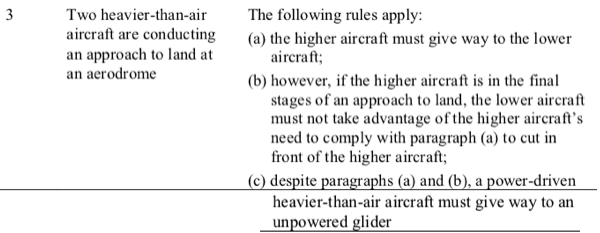
From VFRG version 7.0
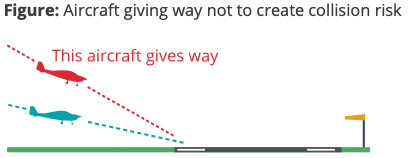 Incorrect
Incorrect

91.330 Right of way rules – item 3

From VFRG version 7.0

-
Question 8 of 20
8. Question
If you have the right of way:
Correct
This is a difficult question to answer. The responsibility is to give way, however once a collision is likely all pilots have a legal and common sense responsibility to take evasive action.
Incorrect
This is a difficult question to answer. The responsibility is to give way, however once a collision is likely all pilots have a legal and common sense responsibility to take evasive action.
-
Question 9 of 20
9. Question
Which is most true in regards to recreational aircraft having any responsibility to keep constant lookout for other aircraft?
Correct
All pilots share this responsibility all of the time.

 Incorrect
Incorrect
All pilots share this responsibility all of the time.


-
Question 10 of 20
10. Question
When overtaking another aircraft:
Correct

91.335 Additional right of way rules – item 2
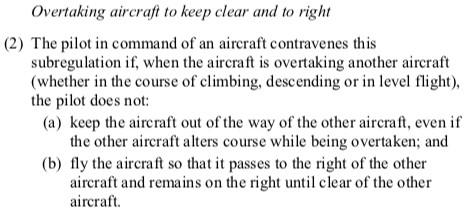
From VFRG version 7.0
 Incorrect
Incorrect

91.335 Additional right of way rules – item 2

From VFRG version 7.0

-
Question 11 of 20
11. Question
Smoking is prohibited within how many metres of an aircraft that is refuelling?
Correct


91.470 smoking within 15 m of an aircraft whilst refuelling creates a fire hazard.
For refuelling see: CAO 20.9 ,CASR 91.470, 91.485, 91.055 and AC 91-25Incorrect


91.470 smoking within 15 m of an aircraft whilst refuelling creates a fire hazard.
For refuelling see: CAO 20.9 ,CASR 91.470, 91.485, 91.055 and AC 91-25 -
Question 12 of 20
12. Question
Alcohol must not be consumed by flight crew within ____ hours of departure.
Correct

91.520 Crew members to be fit for duty
 Incorrect
Incorrect

91.520 Crew members to be fit for duty

-
Question 13 of 20
13. Question
Runways are numbered by:
Correct
Incorrect
-
Question 14 of 20
14. Question
An aircraft on runway 27 would be taking off from:
Correct
The cardinal heading 270 is to the west. Runway numbers are always the way you are heading when you land or take off on that number.
Eg:
Runway 36 is North
Runway 09 is East
Runway 18 is South
Runway 27 is WestIncorrect
The cardinal heading 270 is to the west. Runway numbers are always the way you are heading when you land or take off on that number.
Eg:
Runway 36 is North
Runway 09 is East
Runway 18 is South
Runway 27 is West -
Question 15 of 20
15. Question
An aircraft backtracking on runway 21 would be heading at a bearing of:
Correct
Back-tracking 21 means you are going to takeoff on runway 21. This would mean you are heading 030 while backtracking. On the radio you say backtracking runway 21 and don’t mention 03. This question is to check you understand opposite runway numbers.
Incorrect
Back-tracking 21 means you are going to takeoff on runway 21. This would mean you are heading 030 while backtracking. On the radio you say backtracking runway 21 and don’t mention 03. This question is to check you understand opposite runway numbers.
-
Question 16 of 20
16. Question
The standard circuit pattern involves:
Correct
Standard circuits are left.
Non standard circuits are right or other approaches.
All circuits are left unless advised by ERSA, NOTAM or Circuit indicators.
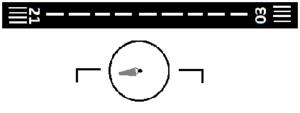
The diagram attached is an example of a circuit indicator. In this case, RWY 03 would have left hand CCTs and RWY 21 would have right hand CCTs.Incorrect
Standard circuits are left.
Non standard circuits are right or other approaches.
All circuits are left unless advised by ERSA, NOTAM or Circuit indicators.

The diagram attached is an example of a circuit indicator. In this case, RWY 03 would have left hand CCTs and RWY 21 would have right hand CCTs. -
Question 17 of 20
17. Question
A standard circuit pattern is generally flown at an altitude of ____ feet.
Correct
For aircraft between 55 kt and 150 kt a standard circuit is 1000 ft.
For aircraft below 55 kt a standard circuit is 500 ft.
For aircraft above 150 kt a standard circuit is 1500 ft.Incorrect
For aircraft between 55 kt and 150 kt a standard circuit is 1000 ft.
For aircraft below 55 kt a standard circuit is 500 ft.
For aircraft above 150 kt a standard circuit is 1500 ft. -
Question 18 of 20
18. Question
In a standard circuit pattern the order of the legs is:
Correct
Some questions in your actual exams are poorly worded and you have to choose the most correct response. Don’t get hung up on the poor wording of a question. Choose the most correct response even if it is ambiguous.
The correct circuit legs are crosswind, downwind, base, final, but there is also upwind if you are doing touch and goes or taking off.
Incorrect
Some questions in your actual exams are poorly worded and you have to choose the most correct response. Don’t get hung up on the poor wording of a question. Choose the most correct response even if it is ambiguous.
The correct circuit legs are crosswind, downwind, base, final, but there is also upwind if you are doing touch and goes or taking off.
-
Question 19 of 20
19. Question
A licensed aerodrome must have:
Correct
They must have one signal display and for your exam you must know the common markers placed in it for gliders, aerodrome closed, and hard surfaces only.
Incorrect
They must have one signal display and for your exam you must know the common markers placed in it for gliders, aerodrome closed, and hard surfaces only.
-
Question 20 of 20
20. Question
Which statement is most true in relation to an aircraft landing under an emergency situation?
Correct

91.330 Right of way rules – item 1 Incorrect
Incorrect

91.330 Right of way rules – item 1
How To Do An Exam How To Do An Exam1.Read carefully & answer questions
2.Click CHECK or SKIP QUESTION
3.Complete all questions
4.Click QUIZ-SUMMARY
5.Click FINISH QUIZ
6.Click VIEW QUESTIONS
7.Scroll down and view all questions
8.Record incorrect responses (red) in A4 book
9.Record where you find that info
How To Do Exam Super Cycles How To Do Exam Super Cycles1.Read question and select answer, then press check.
2.Re-read critical part of question, and answer by saying it out loud or muttering it at least 3 times. (Memory tip)
3.Select NEXT and repeat until you are finished all questions.
4. When finished select QUIZ SUMMARY then FINISH QUIZ to view your score.
5.Then select VIEW QUESTIONS to view all correct and incorrect responses.
6.In A4 book RECORD your result and a LIST of the topics you got wrong.
7.Go to textbook index and record pages for these topic as you will keep getting many of the same questions wrong with study breaks.
8.STUDY from the text your wrong topics, then RETEST after a minimum 10 min break.
9.RECORD study techniques used from HOW TO STUDY VIDEOS and pre or post study test scores, to help identify your best study methods.
How To Record Results How To Record Results1.Explained in How To Study, Video's
2.Allow 1 x A4 page per exam
3.Record incorrect responses (red) in A4 book
4.Give each item a number
5.Record where you found the info
6.The same future mistakes can be recorded as numbers
How To Track Exam Progress How To Track Exam Progress1.Only mark as complete once you master this exam.
2.You can toggle between completed and uncompleted by clicking the button.
3.Many exams serve a limited number and need to be sat multiple times to see all questions.
How To Report Errors How To Report Errors1.Use the blue feedback tab on the right.
2.Take clear shots of the question, the explanation and the answers.
3.Leave a clear comment on the last screen of what is wrong
4.Provide a reference where ever possible.
How To Contact PPE How To Contact PPE1.For errors use the blue feedback tab on the right
2.For non-confidential questions use the Facebook group
3.For confidential only questions use the contact page
4.For login issues, read the FAQ section then use the contact page
5.For tutoring use the blue feedback tab and ask for tutoring
6.Please refrain from using Messenger wherever possible
Why Are Some AIP References Wrong? Why Are Some AIP References Wrong?1.The AIP is constantly changing and so are the references
2.The information you need will be close to the old reference
3.Look just before and just after it to find the info you seek
How To Search Facebook Group How To Search Facebook Group1.Go to the group
2.On desktop, use the search this group box
3.Search for 1 or 2 keywords e.g. order CPL , for order of CPL exams
4.If you don't find what you need, search with slightly different keywords
5.On mobile devices navigate to the group
6.In the top right, click the search icon, use in this group
7.Search for 1 or 2 keywords e.g. order CPL , for order of CPL exams
8.If you don't find what you need, search with slightly different keywords
RA-Aus Air Legislation Exam Progress
Exams Completed: Exams Completed:
